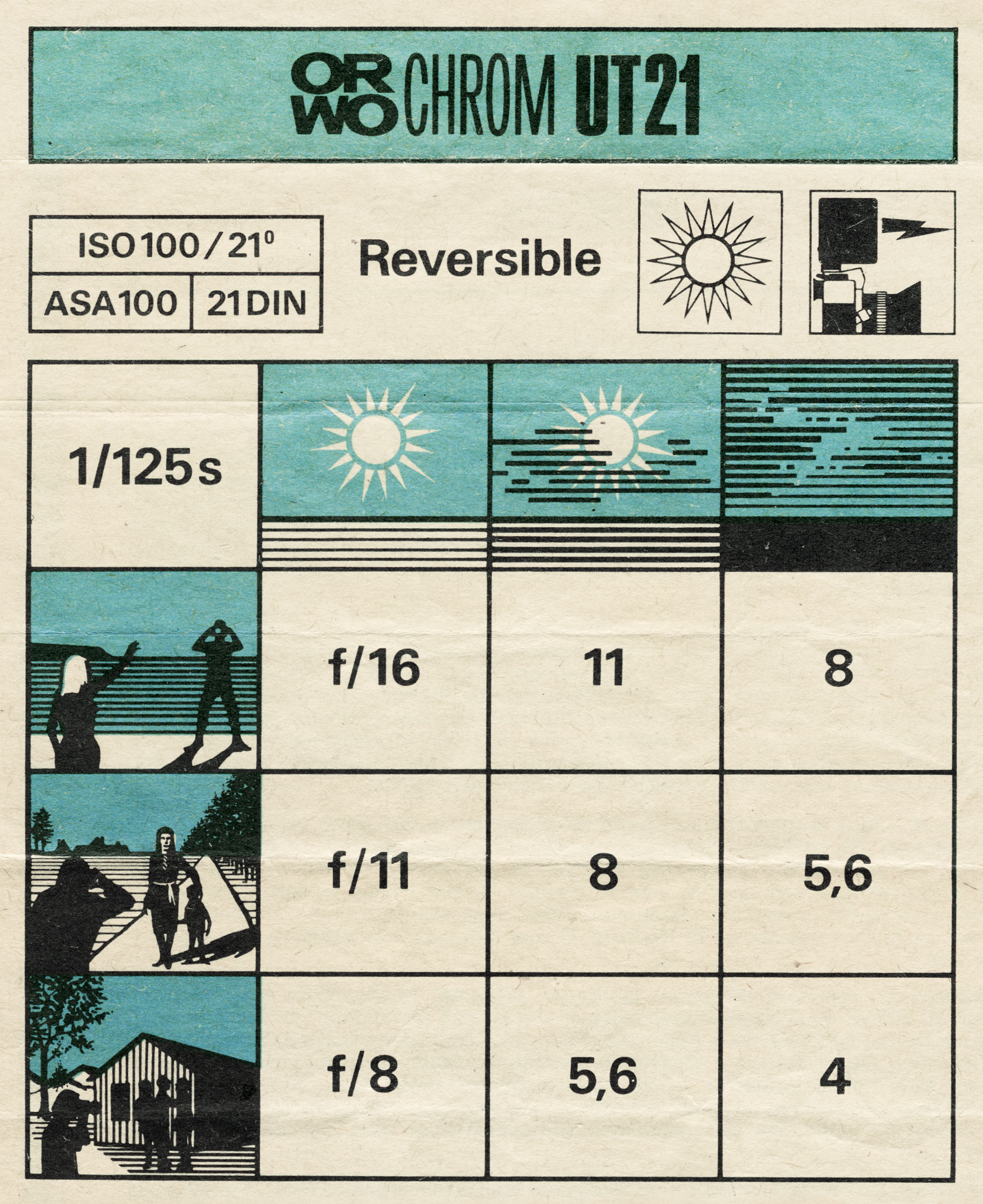Too many words already said about the sunny 16 rule. But, I’ve discovered an old user manual which was included in each box with ORWO CHROM UT21, a 100 ISO color reversal film made by the ORWO film factory in East Germany.
I put it between the pages of a book on photography techniques when I was young and came across it years later.
I really like this table of weather and shooting conditions. But since it has been made especially for reversal films, negative films may become overexposed if you strictly follow its guidelines.
It reminds me of my own “Extended sunny 16 rule” which I follow when I have no exposure meter with me. But still I prefer the matrix of shooting conditions to the classic sunny 16 rule.
| T, sec = 1/ISO | Sunny | Hazy | Cloudy | Overcast | Heavy overcast |
|---|---|---|---|---|---|
| Snow, sand or sea | F22 | F16 | F11 | F8 | F5.6 |
| Direct light | F16 | F11 | F8 | F5.6 | F4 |
| Open shade | F11 | F8 | F5.6 | F4 | F2.8 |
P.S.
Thanks for reading! I would be happy to share my experience of shooting on film, its development, and other practices of using this photographic material. Please, ask me questions in the Leave a reply section below the post. Answers to your questions give me new ideas and allow me to piece better organize my experience.






Tomas
You do not use Pentax 67 metering?
Sasha Krasnov
No, it’s too heavy for me, especially when composing the vertical shot and I sold it. Anyway, the latest model of the metering prism is very accurate. Usually, I use Polaris flash meter.
Tomas
I got what you mean from pictures. I think I will try to use it first. I bought quite a lot things without knowledge, quite crazy… But I believe I will have a lot of fun with it. Are thouse cheap new meters from ebay usefull, do you know? Thanks! By the way, I like your stories to each portrait, but there is no possibility to comment it there, so I do it here. 🙂
Sasha Krasnov
I bought my Polaris flash meter about 20 years ago and still use it because I already have it. But you may at first install software lightmeter on your smartphone or tablet. It gives good results. Anyway, you should test it, especially with your shooting style to understand do you need to add exposure compensation or not. And, when you gain some experience with it you may decide to buy cheap “external” meter like Sekonic or Gossen. Maybe you won’t need it.
Sasha Krasnov
Thank you very much for the feedback about stories. It is really important for me to know!
David McNeice
That’s the neatest formulation of the Sunny-16 table I’ve seen and easily remembered. All you need to remember is the 5 column headings (Sunny through heavy overcast), the three lighting condition rows and the starting f stop numbers in the first column. Thereafter, open up one stop for each column to the right.
Do you also have an extension into artificial light, but not flash? Indoors, street scenes after dusk?
Sasha Krasnov
Thanks for visiting! I think it would be quite difficult to make such a table for artificial light for many reasons — too many options which influent on your current artificial light scheme.
As for street photography, I usually follow this method — I keep in mind calculated exposure for current weather by using this “Sunny 16 rule” and set the exposure. It’s would be a “normal” exposure. And when the subject goes into the shadow I increase the exposure by 2-3 EV by opening the aperture or selecting slower shutter speed for the corresponding value. Changing aperture or shutter speed depends on the current “normal” exposure. If it allows increasing the exposure and keeps the lens not wide open I use operate aperture. Otherwise, I use shutter speed.